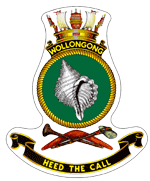HMAS Wollongong (ACPB 92)
| History | |
|---|---|
| Namesake | City of Wollongong, New South Wales |
| Builder | Austal Ships, Henderson, Western Australia |
| Commissioned | 23 June 2007 |
| Homeport | HMAS Cairns, Cairns |
| Motto | "Heed The Call" |
| Honours and awards | Six inherited battle honours |
| Status | Active as of 2011 |
| Badge |  |
| General characteristics | |
| Class and type | Armidale class patrol boat |
| Displacement | 270 tons |
| Length | 56.8 m (186 ft) |
| Beam | 9.5 m (31 ft) |
| Draught | 2.7 m (8.9 ft) |
| Propulsion | 2 x MTU 16V M70 2,320 kW diesels driving twin screws through ZF transmissions |
| Speed | 25 knots (46 km/h; 29 mph) |
| Range | 3,000 nautical miles (5,600 km; 3,500 mi) at 12 knots (22 km/h; 14 mph) |
| Boats & landing craft carried | 2 x Zodiac 7.2 m (24 ft) RHIBs |
| Complement | 21 |
| Sensors and processing systems | Low light optical equipment, communication direction finding and radar |
| Armament | list error: <br /> list (help) 1 x Rafael Typhoon 25 mm naval stabilised deck gun 2 x 12.7 mm machine guns |
HMAS Wollongong (ACPB 92), named for the city of Wollongong, New South Wales, is an Armidale class patrol boat of the Royal Australian Navy (RAN).
Design and construction
The Armidale class patrol boats are 56.8 metres (186 ft) long, with a beam of 9.5 metres (31 ft), a maximum draft of 2.25 metres (7.4 ft), and a displacement of 270 tons.[1][2] The semi-displacement vee hull is fabricated from aluminium alloy, and each vessel is built to a combination of Det Norske Veritas standards for high-speed light craft and RAN requirements.[2] The Armidales can travel at a maximum speed of 25 knots (46 km/h; 29 mph), and are drien by two propeller shafts, each connected to an MTU 16V M70 diesel.[1] The ships have a range of 3,000 nautical miles (5,600 km; 3,500 mi) at 12 knots (22 km/h; 14 mph), allowing them to patrol the waters around the distant territories of Australia, and are designed for standard patrols of 21 days, with a maximum endurance of 42 days.[1][2]
The main armament of the Armidale class is a Rafael Typhoon stabilised 25-millimetre (0.98 in) gun mount fitted with an M242 Bushmaster cannon.[1] Two 12.7-millimetre (0.50 in) machine guns are also carried.[3] Boarding operations are performed by two 7.2-metre (24 ft), waterjet propelled rigid-hulled inflatable boats (RHIBs).[2] Each RHIB is stored in a dedicated cradle and davit, and is capable of operating independanly from the patrol boat as it carries its own communications, navigation, and safety equipment.[2][4]
Each patrol boat has a standard ship's company of 21 personnel, with a maximum of 29.[1][2] The Armidales do not have a permanently assigned ship's company; instead, they are assigned to divisions at a ratio of two vessels to three companies, which rotate through the vessels and allow the Armidales to spend more time at sea, without compromising sailors' rest time or training requirements.[2][5] A 20-berth auxiliary accommodation compartment was included in the design for the transportation of soldiers, illegal fishermen, or unauthorised arrivals; in the latter two cases, the compartment could be secured from the outside.[6] However, a malfunction in the sewerage treatment facilities aboard HMAS Maitland in August 2006 pumped hydrogen sulfide and carbon monoxide into the compartment, non-fatally poisoning four sailors working inside, after which use of the compartment for accommodation was banned across the class.[5][6]
Wollongong was constructed by Austal at their shipyard in Henderson, Western Australia.[1] She was named in February 2007 by Mrs Kylie Heron, wife of Commander Wesley Heron, a former Commanding Officer of the Fremantle class patrol boat HMAS Woolongong.[7] Wollongong was commissioned into the RAN in Sydney, New South Wales on 23 June 2007; a location closer to her namesake city was desirable, but there was no suitable berth at Port Kembla and she was too large for the Wollongong Harbour entrance.[citation needed]
Operational history
Operationally, Wollongong has spent the majority of her career on border patrol to Australia's north and north-west. The ship is assigned to Ardent Division of the Australian Patrol Boat Group, is based in Cairns, and performs border protection and fisheries protection patrols.
In July 2007, the ship became the first vessel of her class to visit the port of Brisbane, Queensland.[8]
Citations
- ^ a b c d e f Wertheim (ed.), The Naval Institute Guide to Combat Fleets of the World, p. 22
- ^ a b c d e f g Kerr, Plain sailing
- ^ Heron & Powell, in Australian Maritime Issues 2006, p. 132
- ^ Heron & Powell, in Australian Maritime Issues 2006, p. 131
- ^ a b Kerr, Patrol boats shake down fuel faults
- ^ a b McKenna, Gas risk remains for navy boats
- ^ HMAS Wollongong ACPB-92 Commissioning Brochure
- ^ [1]
References
- Books
- Heron, Wesley (2007). "Welcome to the Armidale Class". In Forbes, Andrew and Lovi, Michelle (ed.). Australian Maritime Issues 2006 (PDF). Papers in Australian Maritime Affairs. Sea Power Centre - Australia. pp. 129–134. ISBN 0642296448. ISSN 1327-5658. Retrieved 12 May 2010.
{{cite book}}: Unknown parameter|coauthors=ignored (|author=suggested) (help)CS1 maint: multiple names: editors list (link) - Wertheim, Eric, ed. (2007). The Naval Institute Guide to Combat Fleets of the World: Their Ships, Aircraft, and Systems (15th ed.). Annapolis, MD: Naval Institute Press. ISBN 9781591149552. OCLC 140283156.
- Journal and news articles
- Kerr, Julian (1 January 2008). "Plain sailing: Australia's Armidales prove fit for task". Jane's Navy International. Jane's Information Group.
- Kerr, Julian (8 December 2007). "Patrol boats shake down fuel faults". The Australian: Defence Special Report. News Corporation. p. 8.
- McKenna, Michael (2 January 2010). "Gas risk remains for navy boats". The Australian. Retrieved 7 January 2010.
